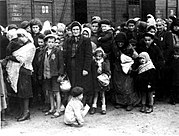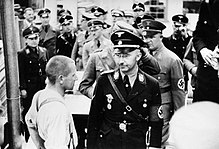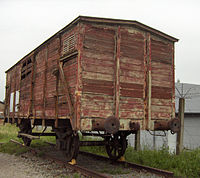
| Home | Sources Directory | News Releases | Calendar | Articles | | Contact | |
Nazi concentration camps
| The Holocaust |
|---|

Part of: Jewish history
|
|
The camps
Nazi concentration camps
Bergen-Belsen – Bogdanovka Buchenwald Dachau – Gross-Rosen Herzogenbusch Janowska – Jasenovac Kaiserwald Maly Trostenets Mauthausen-Gusen Neuengamme – Ravensbrück Sachsenhausen – SajmiÅ¡te Salaspils – Stutthof Theresienstadt Uckermark – Warsaw |
Nazi Germany maintained concentration camps (in German Konzentrationslager, or KZ) throughout the territories it controlled. The first Nazi concentration camps were greatly expanded in Germany after the Reichstag fire in 1933, and were intended to hold political prisoners and opponents of the regime. The number of camps quadrupled between 1939 and 1942 [1] as Jews, political prisoners, criminals, homosexuals, gypsies, the mentally ill and others[2] were incarcerated, generally without trial or judicial process. The term was borrowed from the British concentration camps of the Second Anglo-Boer War. Holocaust scholars draw a distinction between concentration camps (described in this article) and extermination camps, which were established for the industrial-scale murder of the predominantly Jewish ghetto and concentration camp populations. Extermination camps included Belzec, Majdanek, Sobibor, Treblinka, and Auschwitz-Birkenau.
Contents |
[edit] Camps before the war

Once the Nazis came to power in Germany they quickly moved to ruthlessly suppress all real or potential opposition. For example, between 1933 and 1945, the Sondergerichte which were "special courts" set up by the Nazi regime executed 12,000 German nationals.[3] Especially during the first years of their existence these courts "had a strong deterrent effect" against the opposition The German public was intimidated through "arbitrary psychological terror".[4]
Use of the word concentration comes from the idea of concentrating a group of people who are in some way undesirable in one place, where they can be watched by those who incarcerated them. Concentration camp had in the past been used by the U.S. against native Americans, by the British in the Boer wars, and others. The term originated in the "reconcentration camps" set up in Cuba by General Valeriano Weyler in 1897.
The first camp in Germany, Dachau was opened in March 1933,[5] The press statement given at the opening stated:
- "On Wednesday the first concentration camp is to be opened in Dachau with an accommodation for 5000 persons. 'All Communists and'where necessary'Reichsbanner and Social Democratic functionaries who endanger state security are to be concentrated here, as in the long run it is not possible to keep individual functionaries in the state prisons without overburdening these prisons, and on the other hand these people cannot be released because attempts have shown that they persist in their efforts to agitate and organise as soon as they are released.'[5]
It was the first regular concentration camp established by the coalition government of National Socialist German Workers' Party (Nazi Party) and the German Nationalist People's Party (dissolved on 6 July 1933). Heinrich Himmler, then Chief of Police of Munich, officially described the camp as "the first concentration camp for political prisoners."[5]
Dachau served as a prototype and model for the other Nazi concentration camps that followed. Almost every community in Germany had members taken away to these camps, the Newspapers continuously reported of "the removal of the enemies of the Reich to concentration camps", and as early as 1935 there were jingles warning:
Between the years 1933 and 1945 more than 3.5 million Germans would be forced to spend time in these concentration camps or prison for political reasons,[7][8][9] and approximately 77,000 Germans were executed for one or another form of resistance by Special Courts, courts martial, and the civil justice system. Many of these Germans had served in government, the military, or in civil positions, which enabled them to engage in subversion and conspiracy against the Nazis.[10]
Following the holocaust, the term "concentration camp" carries many of the connotations of "extermination camp" and is sometimes used synonymously. Because of these negative connotations, the term "concentration camp", originally itself a euphemism, has been replaced by newer euphemisms such as internment camp, resettlement camp, detention facility, etc., regardless of the actual circumstances of the camp, which can vary a great deal.
[edit] Camps during the war
After 1939, with the beginning of the Second World War, concentration camps increasingly became places where the enemies of the Nazis were enslaved, starved, tortured and killed.[11] During the War concentration camps for 'undesirables' spread throughout Europe. New camps were created near centers of dense 'undesirable' populations, often focusing on areas with large communities of Jews, Polish intelligentsia, Communists or Roma. Since millions of Jews lived in pre-war Poland, most camps were located in the area of General Government in occupied Poland for logistical reasons. It also allowed the Nazis to transport the German Jews outside of the German main territory.
[edit] Internees
The two largest groups containing prisoners in the camps, both numbering in the millions, were Jews and the Soviet prisoners of war (POWs). Large numbers of Roma (or Gypsies), Poles, left of center political prisoners, homosexuals, people with disabilities, Jehovah's Witnesses, Catholic clergy, Eastern European intellectuals, and others'including common criminals. In addition, a small number of Western Allied POWs were sent to concentration camps for various reasons.[12] Western Allied POWs who were Jews, or whom the Nazis believed to be Jewish, were usually sent to ordinary POW camps; however, a small number were sent to concentration camps under antisemitic policies.[13]
Sometimes the concentration camps were used to hold important prisoners, such as the generals involved in the attempted assassination of Hitler; U-boat Captain-turned-Lutheran pastor Martin Niemöller; and Admiral Wilhelm Canaris, who was interned at Flossenbürg on February 7, 1945, until he was hanged on April 9, shortly before the war's end.
In most camps, prisoners were forced to wear identifying overalls with colored badges according to their categorization: red triangles for Communists and other political prisoners, green triangles for common criminals, pink for homosexual men, purple for Jehovah's Witnesses, black for Gypsies and asocials, and yellow for Jews.[14]
[edit] Treatment

Many of prisoners died in the concentration camps through deliberate maltreatment, disease, starvation, and overwork, or were executed as unfit for labor.
Prisoners were transported in inhumane conditions by rail freight cars, in which many died before reaching their destination. The prisoners were confined to the rail cars for days or even weeks, with little or no food or water. Many died of dehydration in the intense heat of summer or froze to death in winter. Concentration camps also existed in Germany itself, and while they were not specifically designed for systematic extermination, many of their inmates perished because of harsh conditions or were executed.
In the early spring of 1941 the SS, along with doctors and officials of the T-4 Euthanasia Program, began killing selected concentration camp prisoners in 'Action 14f13.'[citation needed] The Inspectorate of the Concentration Camps categorized all files dealing with the death of prisoners as 14f, and those of prisoners sent to the T-4 gas chambers as 14f13. Under the language regulations of the SS, selected prisoners were designated for 'special treatment (German: Sonderbehandlung) 14f13'. Prisoners were officially selected based on their medical condition; namely, those permanently unfit for labor due to illness. Unofficially, racial and eugenic criteria were used: Jews, the handicapped, and those with criminal or antisocial records were selected.[15] For Jewish prisoners there was not even the pretense of a medical examination: the arrest record was listed as a physician's 'diagnosis'.[16] In early 1943, as the need for labor increased and the gas chambers at Auschwitz became operational, Heinrich Himmler ordered the end of Action 14f13.[17]

After 1942, many small subcamps were set up near factories to provide forced labour. IG Farben established a synthetic rubber plant in 1942 at Monowitz concentration camp (Auschwitz III); other camps were set up next to airplane factories, coal mines and rocket propellant plants. Conditions were brutal and prisoners were often sent to the gas chambers or killed if they did not work quickly enough.
After much consideration, the extermination of the Jewish prisoners (the 'Final Solution') was announced to high ranking officials at the Wannsee Conference in 1942.[citation needed]
Towards the end of the war, the camps became sites for medical experiments. Eugenics experiments, freezing prisoners to determine how downed pilots were affected by exposure, and experimental and lethal medicines were all tried at various camps. Female prisoners were routinely raped and degraded in the camps.[18]
The camps were liberated by the Allies between 1943 and 1945, often too late to save all the remaining prisoners. For example, when British forces entered Bergen-Belsen concentration camp in 1945, 60,000 prisoners were found alive, but 10,000 died within a week of liberation due to typhus and malnutrition.
The British intelligence service had information about the concentration camps, and in 1942 Jan Karski delivered a thorough eyewitness account to the government.
[edit] Types of camps
According to Moshe Lifshitz[19], the Nazi camps divided as follows:
- Labor camps: concentration camps where interned inmates had to do hard physical labor under inhumane conditions and cruel treatment. Some of these camps were sub-camps of bigger camps, or "operational camps", established for a temporary need.
- Transit and collection camps: camps where inmates were collected and routed to main camps, or temporarily held (Durchgangslager or Dulag).
- POW camps: concentration camps where prisoners of war were held after capture. These POW's endured torture and liquidation on a large scale.
- Camps for rehabilitation and re-education of Poles: camps where the intelligentsia of the ethnic Poles were held, and "re-educated" according to Nazi values as slaves.
- Hostage camps (or death camps): camps where hostages were held and killed as reprisals.
- Extermination camps: These camps differed from the rest, since not all of them were also concentration camps. Although none of the categories is independent, and each camp could be classified as a mixture of several of the above, and all camps had some of the elements of an extermination camp, systematic extermination of new-arrivals occurred in very specific camps. Of these, four were extermination camps, where all new-arrivals were simply killed ' the "Aktion Reinhard" camps (Treblinka, Sobibor and Belzec), together with Chelmno. Two others (Auschwitz and Majdanek) were combined concentration and extermination camps. Others were at times classified as "minor extermination camps".
[edit] Post-war use
Though most Nazi concentration and extermination camps were destroyed after the war, some were made into permanent memorials. In Communist Poland, some camps such as Majdanek, Jaworzno, Potulice and Zgoda were used to hold German Prisoners of War, suspected Nazis and collaborators, anti-Communists and other political prisoners, as well as civilian members of the German and Ukrainian ethnic minorities. Currently memorials remind to both camps in Potulice and enabled a German-Polish discussion on historical perception of WWII. In East Germany (Buchenwald and Sachsenhausen), concentration and extermination camps were used for similar purposes. Dachau concentration camp was used as a prison for arrested Nazis and after that as cheap working-class housing.
[edit] See also
| Wikimedia Commons has media related to: Nazi concentration camps |
- Nazi guards
- Labor camp
- Extermination camp
- Gulag
- NKVD special camps
- List of Nazi-German concentration camps
- German camps in occupied Poland during World War II
- Nazi crimes against ethnic Poles
- Porajmos, the attempted extermination of the Roma people
- Persecution of homosexuals in Nazi Germany and the Holocaust
- Internment
- Ka-tzetnik
- Nazi concentration camp badges
- Nuremberg Trials
- Identification in Nazi camps
- KZ Manager
- War crimes
[edit] References
|
|
Constructs such as ibid. and loc. cit. are discouraged by Wikipedia's style guide for footnotes, as they are easily broken. Please improve this article by replacing them with named references (quick guide), or an abbreviated title. |
- ^ [1] United States Holocaust Memorial Museum: "Nazi Camp System"
- ^ Nazi concentration camp badges Nazi Concentration Camp Badges
- ^ Peter Hoffmann "The History of the German Resistance, 1933-1945"p.xiii
- ^ Andrew Szanajda "The restoration of justice in postwar Hesse, 1945-1949" p.25 "In practice, it signified intimidating the public through arbitrary psychological terror, operating like the courts of the Inquisition." "The Sondergerichte had a strong deterrent effect during the first years of their operation, since their rapid and severe sentencing was feared."
- ^ a b c "Ein Konzentrationslager für politische Gefangene In der Nähe von Dachau" (in German). Münchner Neueste Nachrichten ("The Munich Latest News") (The Holocaust History Project). 21 March 1933. http://www.holocaust-history.org/dachau-gas-chambers/photo.cgi?02.
- ^ Janowitz, Morris (September, 1946). "German Reactions to Nazi Atrocities". The American Journal of Sociology (The University of Chicago Press) 52 (Number 2): 141'146. http://www.jstor.org/pss/2770938.
- ^ Henry Maitles NEVER AGAIN!: A review of David Goldhagen, Hitlers Willing Executioners: Ordinary Germans and the Holocaust", further referenced to G Almond, "The German Resistance Movement", Current History 10 (1946), pp409'527.
- ^ David Clay, "Contending with Hitler: Varieties of German Resistance in the Third Reich", p.122 (1994) ISBN 0-521-41459-8
- ^ Otis C. Mitchell, "Hitler's Nazi state: the years of dictatorial rule, 1934-1945"–Ž (1988), p.217
- ^ Peter Hoffmann "The History of the German Resistance, 1933'1945"p.xiii
- ^ CNN - Army to honor soldiers enslaved by Nazis
- ^ One of the best-known examples was the 168 British Commonwealth and U.S. aviators held for a time at Buchenwald concentration camp. (See: luvnbdy/secondwar/fact_sheets/pow Veterans Affairs Canada, 2006, 'Prisoners of War in the Second World War' and National Museum of the USAF, 'Allied Victims of the Holocaust'.) Two different reasons are suggested for this: the Nazis wanted to make an example of theTerrorflieger ('terror-instilling aviators'), or they classified the downed fliers as spies because they were out of uniform, carrying false papers, or both when apprehended.
- ^ See, for example, Joseph Robert White, 2006, 'Flint Whitlock. Given Up for Dead: American GIs in the Nazi Concentration Camp at Berga' (book review)
- ^ 'Germany and the Camp System' PBS Radio website
- ^ Friedlander, Henry (1995). The Origins of Nazi Genocide: From Euthanasia to the Final Solution. Chapel Hill: University of North Carolina Press. pp. 144.
- ^ Ibid., pp. 147'8
- ^ Ibid., p. 150
- ^ Morrissette, Alana M.: The Experiences of Women During the Holocaust, p. 7.
- ^ Moshe Lifshitz, "Zionism". (ציונות), p. 304
[edit] External links
- Pages show pictures and videos of the day taken at places connected with World War II (Second World War)
- Yad VaShem'The Holocaust Martyrs' and Heroes' Remembrance Authority
- United States Holocaust Memorial Museum Personal Histories - Camps at United States Holocaust Memorial Museum
- The Holocaust History Project
- Official U.S. National Archive Footage of Nazi camps
- Holocaust sites in Germany, Austria, Poland, Czech Republic, France
- Concentration Camps at Jewish Virtual Library
- Memory of the Camps, as shown by PBS Frontline
- [2] Private visit ' Aug 2007
- Podcast with one of 2,000 Danish policemen in Buchenwald
- Nazi Concentration Camp Page with links to original documents!!
|
||||||||||||||||||||||||||
|
SOURCES.COM is an online portal and directory for journalists, news media, researchers and anyone seeking experts, spokespersons, and reliable information resources. Use SOURCES.COM to find experts, media contacts, news releases, background information, scientists, officials, speakers, newsmakers, spokespeople, talk show guests, story ideas, research studies, databases, universities, associations and NGOs, businesses, government spokespeople. Indexing and search applications by Ulli Diemer and Chris DeFreitas.
For information about being included in SOURCES as a expert or spokesperson see the FAQ or use the online membership form. Check here for information about becoming an affiliate. For partnerships, content and applications, and domain name opportunities contact us.


